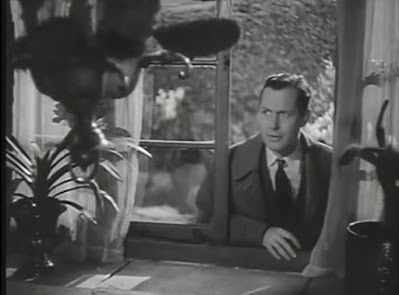Most of them, however, were from the Golden Age of Mystery—the line from "Sleuth" says "when every cabinet minister had a thriller on their nightstand and all detectives were titled." The ones I received were by Dorothy Sayers, a name that was on the back-burner of my mind from browsing at book-stores, but I never entertained reading.
Sayers' most remembered creation is Lord Peter Wimsey—upper-crust, refined, WWI veteran and survivor, a book-collector and frequent "quoter," considered flippant and frivolous, but managed to "fit in" with gentry and commoner alike. He and his loyal butler, Mervyn Bunter, would take on the mantle of amateur sleuths when requested of "The Yard" or when a curious death merely crossed their paths.
During one of those investigations ("Strong Poison" published 1930), Lord Peter falls in love with the object of his investigation, novelist Harriet Vane, who is accused of murdering her lover with arsenic—during their first meeting in the London dock he asks her to marry him, which she refuses, aghast). Over the course of three novels, Wimsey pursues Harriet, until they are finally marry in "Busman's Honeymoon" published 1937.
But, before that, that last was a stage play of the same title, first performed in December 1936. It is for that reason—the adaptation to another medium along with Sayers' aversion for screen adaptations of her work—that it is the only Wimsey story ever filmed (although television serials have been done subsequently).
Raymond Chandler (in his essay "The Simple Art of Murder") griped about the story “a murderer who needs that much help from Providence must be in the wrong business.” One sees his point. The elaborate way in which the murder is committed—and recreated—beggars the logical, but one CAN see where it might make for an entertaining experience for a stage audience.
M-G-M acquired the rights to film the play and three screenwriters are credited with it. There is an extensive re-write as fall as dialogue but everything basically follows the original structure...with some shifting of the weight of exposition. The set-up is this: Lord Peter and Harriet get married and having won his intended, Wimsey, in a sentimental gesture, has purchased the estate of "Tallboy's"—"Elizabethan, very pretty," "a huddle of black gables with two piled chimney stacks"—in the village of Paggleham, not far from where Harriet was raised as a child, and the site of many fondly-remembered visits to the Bateson's who lived there at the time. Harriet had once vowed that should she be able to afford it, that she would purchase it one day. That day has come, purchased from a blunt man called Noakes, who says he will arrange that the place will be set up for the honeymooners. After the wedding and reception the now-newly designated Lord and Lady Wimsey set off for their honeymoon...with butler in tow, gingerly minding their crate of port.
Once there, though, they find the place altogether not ready. Vacated, yes. But, there is still a meal on the table (dash it all!) and no keys made available for easy entrance. What has happened to the man Noakes and why are things in such disarray?
That's the novel's perspective, anyway. Haunted Honeymoon gives us a little more back-story. In the book, we never meet Tallboys' present owner, Noakes. But, the movie has an extended scene where we see a great deal of him, and the various squabbles he has with employees, neighbors, and locals acted out (which we receive in the novel from gossipy hear-say in various interrogations, which, in a movie, might have become tiresome and pedantic). The movie cleans up any extended dialog and things bustle and bounce along with charming village quaintness displayed, giving the impression of Wimsey and Harriet understanding the situation with just the merest mention.
In fact, the reveal and denouement occur so quickly that one may suspect that the two have some sort of precognitive power, rather than any method of deduction. It's no wonder Sayers was horrified, thoroughly dis-owned it, and stated that she would never watch it. The idea!
And let's just be chauvinistic about it: Robert Montgomery just isn't suave, sophisticated, or silly enough to be Peter Wimsey. There's no monocle, he's thoroughly Americanized wisenheimer with an attempt at "jolly-good" positivity thrown in, but it's never consistent like the accent (he's like the "thinnest" of "Thin Men")—Constance Cummings fares better with her formal M-G-M elocution-speech-patterns resembling high talk. Seymour Hicks is much, much too old an actor to be playing Bunter—one could hardly believe that he served with Wimsey during The War, and wouldn't just be patted on the back at the recruiting office and told he'd be better doing "civilian service" 'round 'ome.
Still, it's something. Not unlike the Basil Rathbone Sherlock Holmes series that seems like they should be faithful renditions of the source, but simply aren't, merely neutered imitations to satisfy the folks who've never read them and wouldn't know the difference. The thing is, Sayers is just too complicated and methodical a writer to shoe-horn her stuff into a two-hour movie. Better that they were adapted as a mini-series, and a rather leisurely mini-series at that.








No comments:
Post a Comment